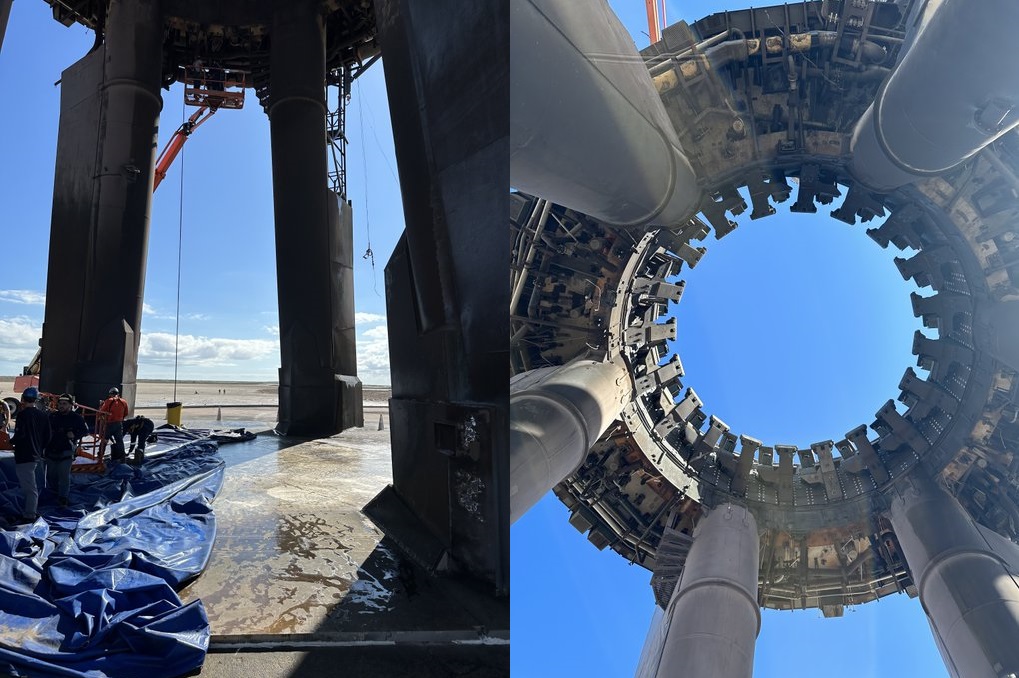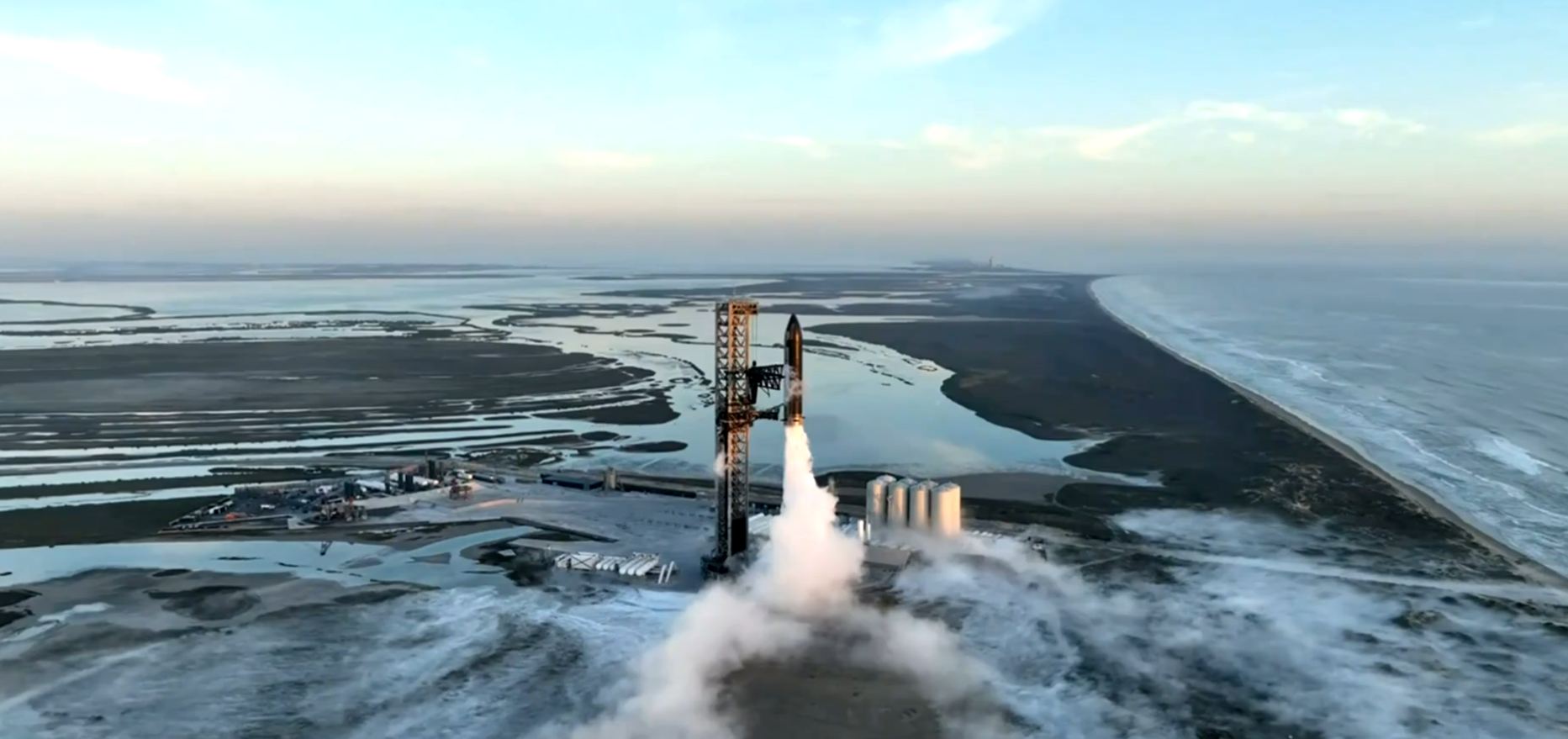After months of waiting, SpaceX made its second attempt at an orbital flight this past Saturday (November 18th). During their previous attempt, which occurred back in April, a fully-stacked Starship (SN24) and Super Heavy (BN7) prototypes managed to make it off the landing pad and reach an altitude of about 40 km (25 miles) above sea level. Unfortunately, the SN24 failed to separate from the BN7 booster a few minutes into the flight, causing the vehicle to fall into an uncontrolled tumble and forcing the ground teams to detonate the onboard charges.
Things went better this time as the SN25 and BN9 prototypes took off at about 7:00 AM local time (8:00 AM EDT; 05:00 AM PDT) from the Starbase launch complex. The SN25 successfully separated from its booster two minutes and fifty seconds later – at an altitude of 70 km (43 mi) – and reached an altitude of about 148 kilometers (92 miles), just shy of SpaceX’s goal of 150 km (~93 mi). However, the booster stage was lost about 30 seconds after separation, exploding over the Gulf of Mexico. The SN25 also exploded about eight minutes into the flight, reportedly because its flight termination system was activated.
Elon Musk chimed in on X after the launch, reposting the company’s live video of the flight test (as well as a shorter slow-motion closeup video taken from the launch tower). Musk also posted pictures of the launch pad the day after the launch to confirm that there was no damage this time around. “Just inspected the Starship launch pad and it is in great condition!” he shared on his X page. “No refurbishment needed to the water-cooled steel plate for next launch. Congrats to @Spacex team & contractors for engineering & building such a robust system so rapidly!”

This is a big improvement over the first launch attempt, which caused significant damage to the landing pad and sent debris in all directions, causing collateral damage to the facility. This was avoided thanks to the water-cooled steel plate, a deluge system installed after the last test. This was one of dozens of corrective measures recommended by the Federal Aviation Administration (FAA), which engineers at Boca Chica have spent months integrating. This included the addition of a forward heat shield interstage to the Starship and expanding the Area of Potential Effects for cultural resources.
Another improvement over the previous test flight was that all 33 of the booster’s Raptor 2 engines ignited this time, whereas 31 ignited the last time. “The real topping on the cake today, that successful liftoff,” said SpaceX commentator John Insprucker. The successful separation of the Starship from the Super Heavy was another major success, as was the altitude achieved, just two kilometers shy of the goal of 150 km (93 mi). “We got so much data, and that will all help us to improve for our next flight,” added commentator Kate Tice.
After the launch, the FAA released a statement about the test, saying that a “mishap” led to the loss of both the spacecraft and booster. “The anomaly resulted in a loss of the vehicle. No injuries or public property damage have been reported,” they said. They also reported that an investigation was underway to determine what went wrong, which is standard procedure whenever a spacecraft is lost. Like the last test flight, SpaceX will not be cleared for more launch tests until the review is complete and corrective measures are taken.
The Starship and Super Heavy is the biggest and most powerful launch system in the world, standing 121 meters (400 feet) tall, weighing 5 million kg (11 million lb), and capable of generating 75.9 meganewtons (MNs) or 17.1 million pounds thrust (lbf). This exceeds the three-stage Saturn V rocket that was the workhorse of the Apollo Program and (until recently) the most powerful rocket ever developed. It also exceeds NASA’s Space Launch System (SLS) that will send the Artemis astronauts to the Moon in the coming years.
The launch vehicle will also play a vital role in the Artemis Program in the form of the Starship Human Landing System (HLS). In April 2021, NASA awarded SpaceX a $3 billion contract to develop the human landing system that will land astronauts on the Moon by 2025 as part of the Artemis III mission. This will consist of four astronauts in an Orion spacecraft launching atop an SLS and rendezvousing in lunar orbit with the Starship HLS – which will launch separately. Two astronauts will transfer to the Starship HLS and use it to descend to the surface, then return to orbit about a week later.
Musk has also been clear that the ultimate aim of the Starship and Super Heavy is to conduct regular missions to Mars that will culminate in the creation of the first self-sustaining city there. Other objectives include sending crews and payloads to the Moon to assist NASA’s plans for a “sustained program of lunar exploration and development” and launching batches of Starlink 2.0 satellites to provide high-broadband internet access to the entire world. With this latest test, SpaceX has taken a significant step in that direction.
On the downside, the booster and spacecraft were lost before the ground teams could attempt the all-important retrieval phase. This is vital for the “entirely reusable” Starship and Super Heavy launch system and Musk’s long-term vision for conducting regular flights to orbit, the Moon, and Mars. On the plus side, this test flight lasted twice as long as the first attempt, and the launch system managed to make it past the Karman Line: 100 km (62 mi) above sea level, the official boundary of “space.” This essentially demonstrated that the Starship and Super Heavy are capable of orbiting flight.
Granted, the rockets need to stop exploding first, but such has always been the way with SpaceX’s rapid prototyping and testing approach. Every launch, even the ones that go “kaboom” – no, especially the ones that go “kaboom” – is another step towards success.
Further Reading: Phys.org


This Launch was a Sucsess. But most of the media says it’s a failure…? SpaceX has been open that its a Prototype and loss of both Viecle’s was going to happend no matter what. And most likely they would not reach all their goal this time around. They did make a a Sucsessful first stage Hotstageing, but I think the plumbing went to hell of the shut down of the firststage engines and the Quick flip made the fuel go the wrong way and the engines got fumes and burned up. And finally they had to blow it it up. Second stage allmost reach their mark aswell. We dont know what went wrong there yet, but my guess off cource by a margine and they needed to terminate the mission. But I guess Elon Musk will Tweet it all for us in a day or two ?